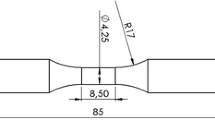Abstract
A smart system for predicting the fatigue strength of metals over a broad temperature range is developed on the basis of a specially trained neural network. The system can predict the number of loading cycles to failure and also the onset of fatigue-crack formation and the rate of crack growth in different test conditions, including low temperatures.






Similar content being viewed by others
REFERENCES
Ivanova, V.S. and Terent’ev, V.F., Priroda ustalosti metallov (Nature of Metal Fatigue), Moscow: Metallurgiya, 1975.
Ivanova, V.S., Ustalostnoe razrushenie metallov (Fatigue Destruction of Metals), Moscow: Metallurgizdat, 1963.
Kabaldin, Yu.G., Shatagin, D.A., Anosov, M.S., et al., Otsenka i diagnostika strukturnoi ustoichivosti metallov pri nizkikh temperaturakh na osnove podkhodov nelineinoi dinamiki i iskusstvennogo intellekta (Assessment and Diagnostics of the Structural Stability of Metals at Low Temperatures Based on the Approaches of Nonlinear Dynamics and Artificial Intelligence), Kabaldin, Yu.G., Ed., Nizhny Novgorod: Nizhegorod. Gos. Tekh. Univ. im. A.A. Alekseeva, 2017.
Koneva, N.A., Teplyakova, L.A., Sosnin, O.V., et al., Transformations of dislocation substructures under fatigue loading, Russ. Phys. J., 2002, vol. 45, no. 3, pp. 303–318.
Aggarwal, C.C., Neural Networks and Deep Learning, Cham: Springer-Verlag, 2016.
Trefilov, V.I., Mil’man, Yu.V., and Firstov, S.A., Fizicheskie osnovy prochnosti tugoplavkikh metallov (Physical Basis of Strength of Refractory Metals), Kiev: Naukova Dumka, 1975.
Novitskii, L.A. and Kozhevnikov, I.G., Teplofizicheskie svoistva materialov pri nizkikh temperaturakh: Spravochnik (Thermophysical Properties of Materials at Low Temperatures: A Handbook), Moscow: Mashinostroenie, 1975.
Carslaw, H.S. and Jaeger, J.C., Conduction of Heat in Solids, Oxford: Oxford Univ. Press, 1959.
Klyavin, O.V., Plasticity and strength of solids in liquid helium, in Problemy prochnosti i plastichnosti tverdykh tel (Problems of Strength and Plasticity of Solids), Moscow: Nauka, 1979, pp. 189–200.
Aleksandrov, V.V., Borzyak, A.I., Boyarskii, S.V., et al., Plastic deformation and destruction of metals at low temperatures, in Fiziko-mekhanicheskie i teplofizicheskie svoistva metallov (Physical-Mechanical and Thermophysical Properties of Metals), Moscow: Nauka, 1974, pp. 179–183.
Funding
Financial support was provided by the Russian Science Fund (project 20-79-00135).
Author information
Authors and Affiliations
Corresponding author
Additional information
Translated by B. Gilbert
About this article
Cite this article
Kabaldin, Y.G., Anosov, M.S., Shatagin, D.A. et al. Neural-Network Prediction of the Low-Temperature Fatigue Strength of Metals. Russ. Engin. Res. 42, 100–103 (2022). https://doi.org/10.3103/S1068798X22020095
Received:
Revised:
Accepted:
Published:
Issue Date:
DOI: https://doi.org/10.3103/S1068798X22020095




